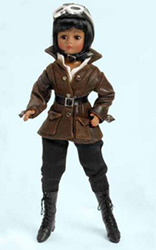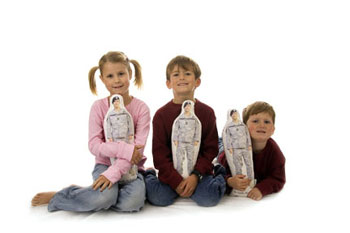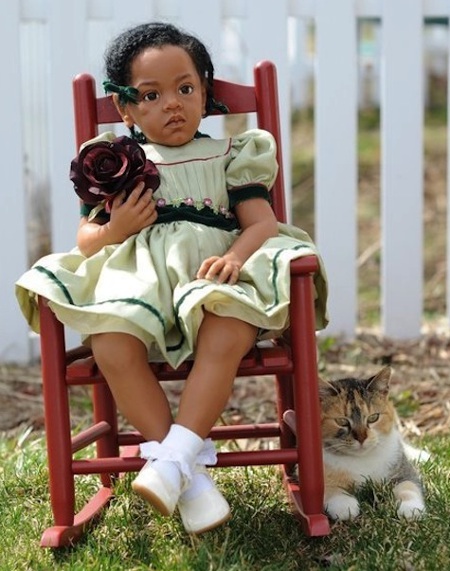There’s a lot of bigotry in this world. I’m sure you don’t need to read a doll blog to figure that out, but I am shocked to realize that I, too, am a bigot—and in a completely indefensible way. I’m not a racist or a homophobe or a political ideologue. No, my prejudice is something more insidious, and ingrained really deep inside. I just realized I judge a doll by her appearance, and—this pains me to admit—I favor pretty faces over plain, ordinary ones. I am a doll-mold monster!
Yes, the truth is sometimes hard to take, and this reflection on me is not a flattering one. But when I hold my doll up to a mirror, I want a sunny, stylish, and special visage to stare back at me. It doesn’t matter if time has dropped a few lines, wrinkles, and blemishes on my countenance; I want my dolls never to lose the first blush of beauty.
This all came to a head—pardon the pun—when I discovered the Girls Explore line of dolls http://store.girls-explore.com/badizadoset.html. The New Jersey-based firm has such a laudable mission: they want to encourage girls “to reach for the stars.” As part of their arsenal to do this, they have a line of doll sets that includes a meticulously sculpted doll along with a book that tells the doll’s life story. The characters that are being offered are all real-live women who made a difference: aviator Amelia Earhart, super athlete Babe Didrikson Zaharias, freedom fighter Harriet Tubman, and pilot Bessie Coleman, to name a few.
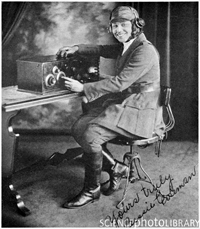
What is so noticeable about these dolls is that they have been sculpted to capture the appearances of their famous figures. The dolls are not creampuffs and onetime runway models—no, they actually resemble the heroines they are depicting: flaws and all.
When I was looking at the Babe Zaharias doll and the Amelia Earhart one, I immediately thought about the Hollywood movies that have told these famous women’s tales. In films, Susan Clark has the distinct privilege of playing both Babe and Amelia; Diane Keaton, Amy Adams, and Hilary Swank have portrayed Amelia as well.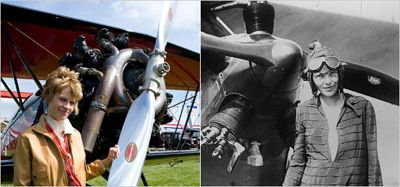 All of these actresses had to be “made-down,” as opposed to “made-up,” to fill these roles. Applauded and lionized for their accomplishments, both Babe and Amelia were NOT lookers. The Girls Explore company knows that “looks don’t matter, achievements do,” and they have made dolls that demonstrate that mantra. I know that truth, too—I preach that all the time—but I have to admit, I am perplexed by these dolls.
All of these actresses had to be “made-down,” as opposed to “made-up,” to fill these roles. Applauded and lionized for their accomplishments, both Babe and Amelia were NOT lookers. The Girls Explore company knows that “looks don’t matter, achievements do,” and they have made dolls that demonstrate that mantra. I know that truth, too—I preach that all the time—but I have to admit, I am perplexed by these dolls.
When I look at their Amelia, I can see that this was a woman who was fearless as she took to the skies.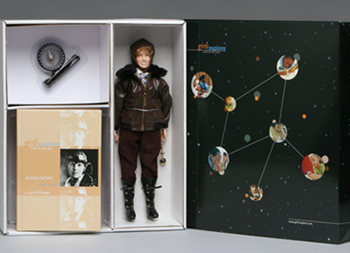 And their rendering of Harriet Tubman is bursting with bravery and dignity. Bessie Coleman, who is less known than the other personages, was the first African-American woman to attain a pilot’s license, and the first woman to receive an international pilot’s license. She opened a flight school to teach other women how to fly, and lobbied to encourage fellow African Americans to overcome poverty and discouragement by literally rising above it all. That sums up the whole notion of “reaching for the stars” beautifully and lyrically.
And their rendering of Harriet Tubman is bursting with bravery and dignity. Bessie Coleman, who is less known than the other personages, was the first African-American woman to attain a pilot’s license, and the first woman to receive an international pilot’s license. She opened a flight school to teach other women how to fly, and lobbied to encourage fellow African Americans to overcome poverty and discouragement by literally rising above it all. That sums up the whole notion of “reaching for the stars” beautifully and lyrically.
Why, then, when I look at this lineup of women who made a difference, do I think, “Hmm, too bad they don’t look more like my Gene or Barbie or Tyler dolls?” Why is my first thought: “Will little girls want to play with them? They’re not that attractive.”
Over the years, we’ve all been exposed to dolls that have been garbed as well-known characters. Barbie has been dressed as Cleopatra and Queen Elizabeth, Olivia Newton-John and Isaac Newton. (Okay, I’m kidding about Isaac Newton, but she has been decked out as a scientist.) Gene, as a make-believe movie star, had costumes that spanned decades and professions. She was able to dress the part, but did not necessarily “look” the part. How many WACs actually wore eye shadow and lipstick so thick that it could be spotted by B-52s buzzing above? I doubt that many, but Gene went to war with full “war paint” covering her pouty face.
I guess I am a hobby hypocrite. In real life, I am all for being judged on one’s talents and abilities. The idea of the “pretty preference,” which does exist in schools and the workplace, irks me. Why should a person receive inflated grades and undeserved promotions because of a genetic blessing? Why should better DNA translate into an unearned A or B? However, when it comes to dolls, I am much more comfortable with a Bessie Coleman doll that looks more like Halle Berry or Beyoncé. I’m not proud of this; I’m just stating a fact.
It’s ironic that I discovered this company and its offerings now in February, the start of Black History Month. I think about Dr. King and his exhortation to judge others by the content of their character, and not the color of their skin.
I hope I can carry that open-minded viewpoint into my doll-buying life: after all, it would be nice to bring the Mary Cassatt doll home and have her inspire my artistically talented daughter and son. It seems to me, this company has a lot to teach all of us, not just girls. I think we all can reach for the stars, by reaching deeper into our better selves.
What do you think about dolls that dare to stray away from the beautiful and the adorable? Would you buy a doll that is just ordinary or average in her appearance, or are you more inclined to be smitten by the cuter, prettier ones? I’d love to hear. Please share your thoughts below!

